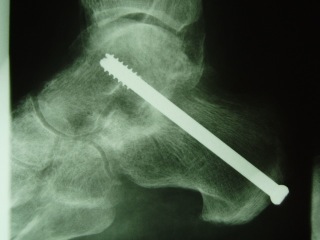Subtalar Fusion (Open)

The subtalar joint is below the ankle joint and allows side-to-side or tilt movements of the heel – it allows your foot to move in circulator rotations and side to side making walking on uneven surfaces possible.
Over time the bone surfaces in your subtalar joint can suffer wear and tear due to injury or arthritis.This operation removes the degenerate joint and fixes the joint together, with the aim that bone will grow across and 'fuse' the joint. The joint will then be rigid and no longer painful. There will be no change in the up/down movement of the ankle. Walking will not be altered on flat ground, only on uneven surfaces, when the ankle will feel a little 'inflexible'.
The surgery is performed through a 5cm incision over the outer side of the ankle. The arthritic joint surfaces are excised (cut out) and the joint fixed together with a screw through the heel. The operation takes approximately 1.5 hours.
Risks of surgery
Swelling
Initially the foot will be very swollen and needs elevating. The swelling will disperse over the following weeks & months but will still be apparent at 6-9 months.
Infection
This is the biggest risk with this type of surgery. You will be given intravenous antibiotics to prevent against it. The best way to reduce the chance of acquiring an infection is to keep the foot elevated for 14 days. If there is a mild infection, it often resolves with oral antibiotics. If the infection is severe, it may warrant admission to hospital and intravenous antibiotics. A severe infection often results in failure of the fusion, and extremely rarely may result in an amputation at a later date.
Malposition
Ideally, the fusion is positioned to allow optimum function and give the best appearance. I take great efforts to judge the best position for the fusion at surgery, but as you are asleep and lying down, it is not always possible to achieve this 'best' position. If the position is not optimal following surgery, most deformities can be accommodated by insoles and shoeware. Rarely is further surgery required.
Non Union
This is when the joint fails to fuse and bone has not grown across the joint. We won't know whether this is the case for 6-12 months. The risk of this is approximately 5%. Smoking increases this risk 16 times.
If a non union does occur and is painful, then further surgery is usually needed.
Nerve Damage
Alongside the incision are two nerves – the superficial peroneal and the sural nerves. They supply sensation to the side and the top of the foot and toes. They may become damaged during the surgery and this will leave a patch of numbness, either at the side of the foot or over the top of the foot and toes. This numbness may be temporary or permanent. There is approximately a 10% of this happening.
Recovery from surgery
After surgery, your leg will be immobilised in a backslab (half plaster) for 2 weeks. Elevation of the foot (above the pelvis) for the first 10 days is vitally important to prevent infection. Naturally, small periods of walking and standing are necessary, but no weight must be taken through this leg for 6 weeks.
The total time in plaster cast is normally six weeks. After 2 weeks the backslab will be removed and the stitches taken out, here in clinic. Another non-weight bearing plaster is applied for a further 4 weeks. At this stage you will be reviewed in clinic with x-rays. If all is well, you can begin walking out of plaster at that stage. Usually no physiotherapy is required. If the fusion is slow to heal, then a further 6 weeks in a weight bearing cast will be necessary.
Activity and time off work
In general, up to 4 weeks off work is required for sedentary posts. 10 weeks for standing or walking posts. 12 weeks for manual / labour intensive posts.
Your subtalar joint needs to be fully fused before you can drive.
Follow up
- 2 Weeks for removal of sutures & COP
- 6 Weeks Mr Rosenfeld's clinic – WB AP & Lateral X-rays / Removal of Plaster
- 3 Months - X-ray Ankle WB AP & Lateral
- 6 Months for final assessment if no complications